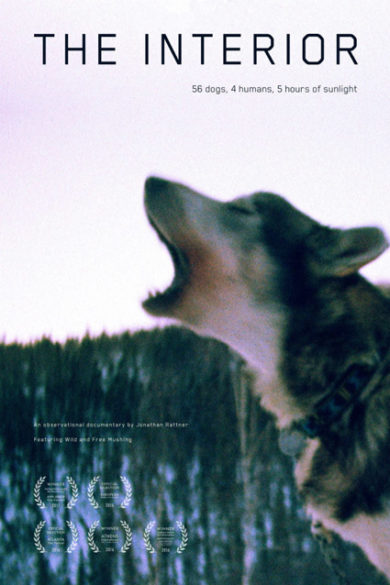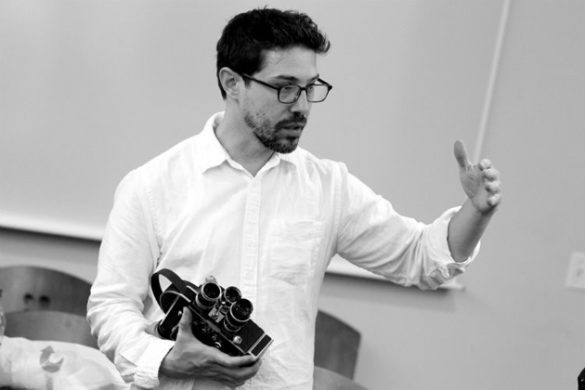Jonathan Rattner’s passion for creating observational films that draw the audience into places often unseen or forgotten is reflected in The Interior, his award-winning experimental documentary that will be screened at the 2017 Southern Festival of Books.
The screening and Q&A with Rattner will be Sunday, Oct. 15, from noon to 1 p.m. at the Nashville Public Library.
The Interior takes place deep inside rural Alaska, where he said it “opens a window” on a day in the life of professional dog musher Brent Sass, who lives and works with his family of 56 dogs.
“I have a strong interest in creating narratives about place—not only where we live but also how we idealize and even mythologize certain places,” said Rattner, an intermedia artist and assistant professor of cinema and media arts at Vanderbilt University. “The Alaskan environment has intrigued me for a long time, so this was a dream come true for me as a filmmaker.”
 One of the elements that stands out about The Interior is that there is no dialogue between people, but the film vividly shows Sass communicating with his dogs while traveling the snow-packed wilderness as well as at home.
One of the elements that stands out about The Interior is that there is no dialogue between people, but the film vividly shows Sass communicating with his dogs while traveling the snow-packed wilderness as well as at home.
“Prior to my arrival in Alaska, I had some concerns about how I would feel being ‘in the middle of nowhere,’ filming so many dogs and one individual,” Rattner said. “What I quickly learned was that Brent provides a very safe and caring environment for his dogs, and he lets them run free at times, although not all 56 at once!”
The Interior, shot on both 16mm and digital video, is described by Rattner as both romantic and anti-romantic. “While the film depicts the quiet beauty of the landscape, there is also the reality of a dog musher’s life—waking up early, spending long hours in the frigid cold and making sure the animals are healthy and safe. These dogs are not pets, but they are still cared for deeply,” said Rattner, who also has a faculty appointment in the Department of Art.
Rattner said that when he reached out to Sass about making the film, he emphasized his interest in creating something different than what is typically shown about Alaska on television or at the movie theater.
“Rather than construct a rhetorical document, my work is more lyrical and sensual in nature,” Rattner said. “In my films, I strive to create new perspectives of the world around us in which our vision and hearing is heightened by the editing, sound design and cinematography.”
One of the most surprising things the filmmaker found was how peaceful and happy the dog musher’s environment was. “Most of the time it was very quiet, but suddenly you would hear dozens of dogs howling.

“To me, the sonic rhythm from silence to semi-random intense barking was exciting and refreshing, a little like the experience of listening to avant-garde or experimental music—music which surprises and sparks,” Rattner said.
One alumnus and two then-undergraduate students—all of whom majored in cinema and media arts and earned bachelor’s degrees in the College of Arts and Science—assisted Rattner on The Interior. Sebastian Lasaosa Rogers, Class of 2013, traveled with Rattner to Alaska as an assistant for camera and sound recording. “The natural beauty of interior Alaska impacted me on a profound emotional level that took me by surprise,” Rogers said. “Of course, the 35-below-zero temperatures presented new and exciting technical challenges.”
Rogers is working in New York City as a director of photography and camera assistant, in addition to working on his own projects as an independent filmmaker. He noted that Rattner, his former major adviser, continues to be a colleague and offers valuable feedback on Rogers’ work.
Robert Kuhn, who graduated in 2014, worked on pre-production as a student intern. He appreciated that Rattner was open to using different methods of filmmaking but pushed students to defend each decision in the artistic process. “A lot of the pre-production process was thinking about what equipment would be right for the realities of shooting in Alaska, as well as for the director’s creative vision,” Kuhn said. “Professor Rattner is not the type of person to plan out all of the shots, but he believes that being prepared for every single circumstance is important. That way the filmmaker can be freed up at a moment’s notice to make stylistic decisions. My job was to make sure that he was well-equipped to make those choices.”
Kuhn is a junior copywriter at the Leo Burnett Advertising Agency in Chicago. “What always intrigued me about the creative side of advertising is the idea of being put in boxes and having to work your way out of them,” he said. “What I learned from the filmmaking experience and from Professor Rattner is that creativity is really just a series of choices. You always have to choose the best one based on the situation presented to you.”
Hillary Good, Class of 2016, contributed to research and post-production with support from the Littlejohn Family Undergraduate Research Program. She worked as an assistant editor and helped plan screenings at festivals and museums around the world for The Interior.
Good said that working with Rattner was a remarkable opportunity. “I was able to practice and apply the skills I had learned in the classroom to the project, as well as gain insight about what it means to be an independent filmmaker,” Good said. “The Interior’s amazing honors and awards speak to Rattner’s ability to communicate story and passion through film, and I’m glad to have been a small part on the project.”
Good recently completed an internship at PBS and has a position teaching animation to children in New York City.
The Interior’s numerous awards include a documentary award at the Athens International Film and Video Festival, an audience award at the Anthology Film Archives and the Michael Moore Award for Best Documentary at the Ann Arbor Film Festival.
Other places where Rattner has exhibited his work include the Atlanta Film Festival, the University of Iowa Museum of Art, Glasgow Centre of Contemporary Arts, L’Alternativa Independent Film Festival, Currents New Media Festival, the European Media Arts Festival, and the Walker Art Center/Museum, which recently acquired The Interior for its permanent collection.